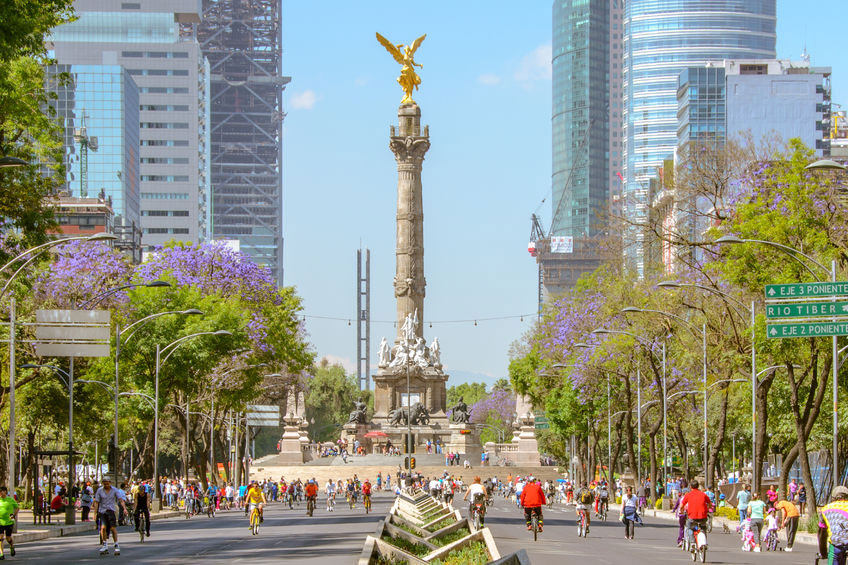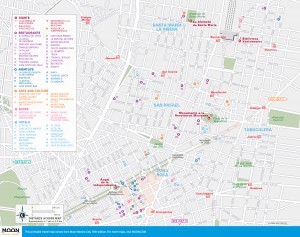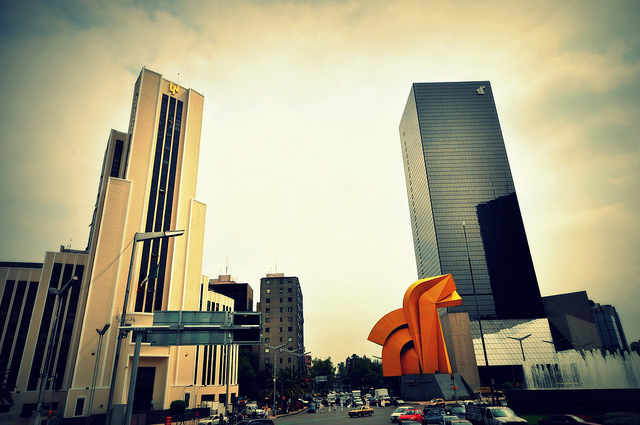
The Ángel de la Independencia is a symbol of national pride and commemorates the country’s independence from Spain. Photo © fotointeractiva/123rf.

Paseo de la Reforma, Zona Rosa, San Rafael
The central stretch of the Paseo de la Reforma, which runs from the Centro Histórico through the Bosque de Chapultepec, is one of the city’s main thoroughfares, as well as one of its signature landmarks. A wide, old-fashioned avenue originally designed to resemble the grand boulevards of Europe, it was first commissioned by Hapsburg emperor Maximilian and completed by President Porfirio Díaz at the end of the 19th century. Fashionable neighborhoods cropped up quickly along Reforma in its early days, and the avenue remains one of the most exclusive addresses in the city, even if its luxury hotels, embassies, and high-rises are now interspersed with banks and convenience stores.On Sundays, the avenue is closed to automobile traffic, so it’s a wonderful time to take a stroll or rent a bike for a leisurely exploration of Reforma’s many monuments and public sculptures. In addition, there are often temporary art exhibits installed along the lateral roads, where manicured gardens are periodically planted with seasonal greenery, from colorful spring flowers to pretty fields of poinsettia during Christmastime.

Edificio El Moro (La Lotería) and Torre del Caballito along Paseo de la Reforma. Photo © pegatina1, licensed Creative Commons Attribution No-Derivatives.
Occupying the enviable address Paseo de la Reforma 1, the wonderful art deco Edificio El Moro—better known to many as La Lotería, the home of the national lottery—was inaugurated in 1945. This elegant skyscraper, with its strip of windows running up the front facade, was once the highest building in Mexico City. Beside it, a statue of King Carlos of Spain originally marked the start of Reforma; it has been replaced by a giant yellow modernist interpretation of a king on horseback by sculptor Sebastián.
Cast in 1877 by French sculptor Charles Cordier, the Monumento de Colón (Monument to Christopher Columbus) still stands despite the best efforts of political protesters who’d like to take it down. Farther south, at the intersection of the city’s two most important avenues, Insurgentes and Reforma, stands a statue of Emperor Cuauhtémoc, who led the Mexica people in a desperate last stand against the Spaniards before the fall of Tenochtitlán in 1519.
Just west of Insurgentes, the next traffic circle (with a palm tree at its center) is adjoined by the mirrored Bolsa Mexicana de Valores, the home of the Mexican stock exchange. This futuristic building is notable for its glassy, spherical entryway, joined by a unusual three-section skyscraper, entirely covered in mirrors. The architect who designed it also created the spherical TAPO bus station, with which the stock exchange boasts some similarities. Halfway up the block, the U.S. Embassy (blocked off by giant fences since 2001) isn’t much to look at, but it is thronged every day by a snaking line of Mexican visa applicants waiting for their appointments. At the following intersection, one of the most iconic landmarks in Mexico City, the Ángel de la Independencia, was erected by President Porfirio Díaz as a tribute to Mexico’s independence from Spain.
At the westernmost glorieta (traffic circle) before Chapultepec, the circular fountain is topped by a statue of the Greek goddess Diana Cazadora (Diana the Huntress). It was originally constructed in 1942, and her nudity created such a scandal with ultra-conservatives that the sculptor, Juan Francisco Olaguíbel, was forced to add bronze undergarments to the piece. Eventually, as society gradually liberalized, the sculpture no longer seemed so scandalous, and the bronze clothing was removed in 1967, in anticipation of the Mexico City Olympics in 1968.
Just east of the main entrance to the Bosque de Chapultepec, the 225-meter Torre Mayor is the tallest building in Mexico, a glittering gray-glass and pink-granite tower that overlooks the park. Across the street, Reforma’s newest monument is the Estela de la Luz (Pillar of Light), a 104-meter, quartz-covered tower commemorating 2010’s bicentennial of independence from Spain and the concurrent centennial of the Revolution of 1910. Its construction was mired in controversy, first by going massively over budget and later for overshooting its September 2010 construction deadline by 15 months and missing the anniversary celebrations altogether.
The Paseo de la Reforma runs right through the wooded forests of the primera sección (first section) of the Bosque de Chapultepec, where the famous green rejas (fences) that border the park host ongoing public photography exhibits, often showcasing historical images of Mexico. Walking along Reforma here, either in the pedestrian median (where there are also sculpture exhibits) or along the sidewalks, you’ll see the Museo Rufino Tamayo to your north and the Museo de Arte Moderno, Museo Nacional de Antropología, and zoo to the south.
Excerpted from the Fifth Edition of Moon Mexico City.